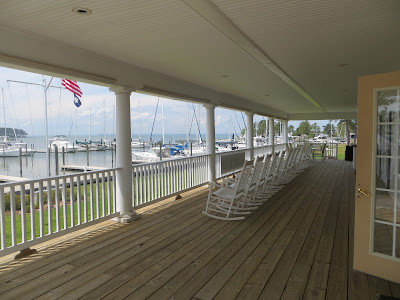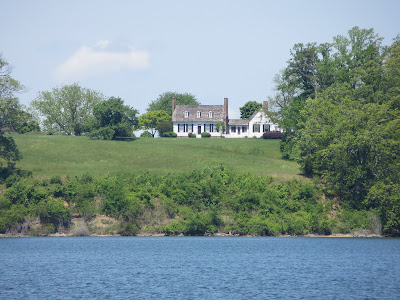All types, including aircraft carriers.
The lighthouse at Hampton, VA on the north side of the James River.
The container ship HS Livingston from Malta was inbound from the Atlantic, clipping along at a pretty good speed and creating a pretty good wake. There was not much room in the channel, and she put out about a 5-foot wake for us to cross. Let's just say it rearranged the furniture in the boat!
Our friends, Don and Judy aboard "Suite Endeavor," were underway again also, heading to Reedsville, VA for the evening which would put them only one more day away from their home in Kinsale, VA.
As you proceed up the western shore of the Chesapeake Bay, there are many places to stop. The bay is huge and you could take years to see it all. So, we can only pick a few as we only have a couple of weeks. Our goal the first day was to reach Deltaville, VA, about 55 miles north from Portsmouth. There are several significant markers identifying shoaled areas on your port side moving northbound. The first one is Wolf Trap Light, a 52-foot caisson (watertight retaining) structure.
As we made the turn up the Rappahannock River toward Deltaville, we passed a yellow floating buoy that was new to us. With a little research, we found that these are part of the Chesapeake Bay Interpretive Buoy System (CBIBS), a network of observational buoys that are deployed throughout the Chesapeake to observe the estuary's changing conditions and to serve as way points along the Captain John Smith Chesapeake National Historic Trail. They are maintained by NOAA. These "smart buoys" observe and record meteorological, oceanographic, and water quality data which can be obtained in real-time by calling 1-877-BUOY-BAY or by logging on to http://buoybay.noaa.gov. Cool.
Dozier's Regatta Point is a popular stop. The town of Deltaville is very small with a population of only 800 residents, but in the boating season it swells to thousands and several thousand boats are based there as well. From a historical perspective, the tip end of Deltaville is Stingray Point which is commonly believed to be named from the early 17th century. According to legend, Captain John Smith was stung by a stingray there while exploring the bay. Captain Smith is said to have given orders to his men for the disposal of his body, before a cure was given to them by local Native Americans, who lived along what is now called Antipoison Creek. We had plans to visit Stingray Point but got rained out, so we visited with two different sailboat couples most of the evening. Here are a few pictures of Dozier's which is also known for the popular "Waterway Cruising Guides" and "Skipper Bob" books.
Dozier's had a courtesy car available so we made a trip into town for West Marine, a hardware store for a cable connection, and groceries. We got an early start the next morning for a 58-mile run to St. Marys, MD. At one of the widest points of the bay, about 25 miles, we began to see this huge "thing" rising up out of the horizon, the view of which is normally only about 11 miles. It appeared to be moving quickly and headed toward us. We were a little concerned after the huge wake we encountered the day before. Take a look and you should understand why. And this picture is from at least 3 miles away!
Turns out it is the "Eurasian Highway" from Japan, bound for Philadelphia and Baltimore, carrying cars and trucks, probably Toyotas! It was built in 2012 and cruises at 16 knots. By the time its wake got to us it was more like rolling swells so it wasn't too bad.
Now this next shot probably looks to you to be just a regular shot off the bow of our boat. Oh no, do not be fooled by the simplicity of the photo - this is crossing the Virginia/Maryland state line as we made the turn up the mouth of the Potomac River!
There's another significant shoal marker at this point - Smith Point Lighthouse. This huge marker is now unmanned and automatic and was sold into private hands in 2005 and was recently renovated as a 4-bedroom home! Now that's different, huh?
About this time we see another vessel in the distance heading our way and it appears to be a huge container ship - here we go again. You have to look closely in the far distance of the horizon.
Closer, and yes, she's big.
As it turned out, this one continued up the main channel of the bay as we continued NW-bound up the Potomac. At it's closest point, Rhonda got this really cool picture of it that also picked up nine different vessels at varying distances on the horizon. I love this picture, especially the small sailboat in the foreground!
The next significant marker was not nearly as interesting as the last one but is just as important, marking the shoal areas on the southern tip of Lookout Point. It's a "skeleton" tower only. You can still see the container ship in the distance.
We had to be careful in this area for "Fish Trap Areas and Structures." They are designated in general areas on the charts so you have to watch out for the actual individual locations. One possibility was heavy concentrations of crab pots. The heaviest concentration of traps was marked with flags on both ends, easily visible if you are paying attention, but it would be easy to wander into one of these areas if you were running on autopilot and not paying attention. The other possibility was new to us - areas of stakes and nets that were easily visible, and we noted several of these along the banks of the Potomac and as we made the turn up the St. Marys River.
The water was like glass on the St. Marys River.
And for the first time in it seems like forever, we are seeing hills again. Several homes were positioned along the banks of the river.
We spotted some folks on the shore - looks like spring is definitely here in Maryland! Turns out these are students from St. Marys College, our destination for the afternoon. We picked this stop for three reasons. (1) The college has a significant boating setting. They welcome transient boaters and you can eat on campus. (2) St. Marys was the original capitol of Maryland before it was moved to Annapolis, so lots of history to see. (3) The anchorages in the area are referred to in the cruising guides as some of the prettiest on the Chesapeake Bay.
Here's the waterfront at the college.
Here's Help Me Rhonda docked for a visit.
We had no idea that it was senior week and were not expecting quite the display of bodies (I mean seniors) basically partying in anticipation of their graduation the next day. Rhonda encouraged me to try and discreetly get some shots (seriously, she did, and she proof-reads these blogs before I post them), so I did. I guess this is why the guide book calls St. Marys one of the most "scenic" spots on the Chesapeake!
It took us a while to work our way to shore as we had to walk through several areas of sunbathers sprawled all over the docks. Just part of the rigors of boating I guess but somebody has got to do it! It was funny - when we finally got to shore we struck up a conversation with one of the students. She said you basically have two groups here. She pointed to the right and said "those are the drunks and I'm over here (pointing to the left) with the non-drunks." As we observed, the "drunks" were falling in the water over and over again and the "non-drunks" seemed to be enjoying themselves utilizing all of the different types of boats available to them.
Some other students were out throwing frisbees.
The college campus was beautiful as you can see above. Here's the entrance.
All of this, especially the emphasis on boating activities and sunbathing, kind of made me want to go back to college again. But, then I remembered you still have to go to class, study, take tests/exams, etc. - not my forte' so probably better off just cruising the waterways in my slightly different version of "senior" years.
Moving on to the history - in the early 1600s, two boats, The Dove and The Ark, departed England for the first planned colony of Maryland. The two ships originally sailed with 128 settlers on board ship but were brought back to England by the Royal Navy in order that the settlers might take an oath of allegiance to the King. The oath sworn, they sailed again in October 1632 for the Isle Of Wight to collect more settlers, including two Jesuit priests and almost two hundred further settlers, before sailing for Maryland. The ships were initially separated at sea, but were reunited six weeks later at Barbados. On March the 27th they landed at what is now St. Marys, then the site of a Native American village, and they began the work of establishing a settlement there. In August 1635, the Dove sailed for England carrying timber and beaver pelts, but she never arrived home and was presumed lost in a storm. Here's a replica of the Dove on display at St. Marys today.
St. Marys became the first capital of Maryland and they have a replica of the first state house from 1676.
There is a monument to the state house, and it is located at the original site which is now a cemetery.
There is a replica of the village area.
It's hard to believe the pillory and stocks are still standing. (That's a joke.)
We finished the history tour and worked our way back to the boat. The students were still at it until about 5 PM. After the wind died down, we left the dock for our anchorage, which was in fact very nice. It's hard to capture the setting for an anchorage with one picture, but this was the best I could do. It was a nice pleasant and quiet evening.
We worked our way back down the St. Marys River the next day for the Corinthian Yacht Club at Ridge, MD. They had a Looper special going on which we decided to try. More on that later.





































No comments:
Post a Comment